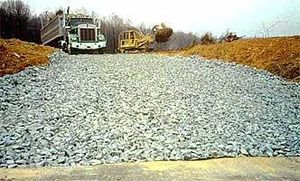
Difference between revisions of "Construction stormwater program"
m |
m |
||
| Line 28: | Line 28: | ||
==Best Management Practices== | ==Best Management Practices== | ||
| − | *[[Erosion prevention practices]] - Links to a page that provides a portal to information on individual erosion prevention practices | + | *[[Erosion prevention practices]] - Links to a page that provides a portal to information on individual erosion prevention practices. Contains <font size=4>'''NEW!</font size> information. |
*[[Sediment control practices]] - Links to a page that provides a portal to information on individual sediment control practices | *[[Sediment control practices]] - Links to a page that provides a portal to information on individual sediment control practices | ||
*[[Construction stormwater treatment]] | *[[Construction stormwater treatment]] | ||
Revision as of 18:19, 9 April 2019
When stormwater drains off a construction site, it carries sediment and other pollutants that harm lakes, streams and wetlands. According to the 1996 National Water Quality Inventory, stormwater runoff is a leading source of water pollution. The U.S. Environmental Protection Agency estimates that 20 to 150 tons of soil per acre are lost every year to stormwater runoff from construction sites.
Controlling erosion can significantly reduce the amount of sedimentation and other pollutants transported by runoff from construction sites. To keep Minnesota’s valuable water resources clean the Minnesota Pollution Control Agency (MPCA) issues permits to construction site owners and their operators to prevent stormwater pollution during and after construction.
This page provides links to pages that address topics related to construction stormwater.
Contents
Construction Stormwater permit
- 2018 permit
- File:What's new in the 2018 Construction Permit.pdf
- 2013 permit
- Construction stormwater permit overview and permit application
- Construction stormwater permit and program forms
- Construction stormwater permit general information
Guidance, tools, and resources for construction stormwater
- Who needs a Construction Stormwater Permit?
- Construction Stormwater Permit timelines
- Construction stormwater permit fact sheets
- Planning, scheduling, and sequencing for construction
Best Management Practices
- Erosion prevention practices - Links to a page that provides a portal to information on individual erosion prevention practices. Contains NEW! information.
- Sediment control practices - Links to a page that provides a portal to information on individual sediment control practices
- Construction stormwater treatment
- Construction practices to minimize sediment discharge
- Winter construction practices for site stabilization, erosion prevention and sediment control
- General principles for erosion prevention and sediment control at construction sites in Minnesota
- NEW! - 10 Steps to Stormwater Pollution Prevention on Small Residential Construction Sites: An interactive image illustrating stormwater practices at small construction sites.
- Links for construction stormwater
- Construction stormwater inspection checklist
Other links
- Construction stormwater photo gallery
- Alleviating compaction from construction activities
- Links for construction stormwater
- Definitions and terminology for construction stormwater
- Construction stormwater technical support documents for manual updates
- Construction Program FAQ
Construction Stormwater Permit Application
Click here to log into the e-Services then once logged in, click on Construction Stormwater General Permit Application
Visa, Master cards or checks are accepted for the $400 fee payment.
Construction stormwater permit application - FAQ

